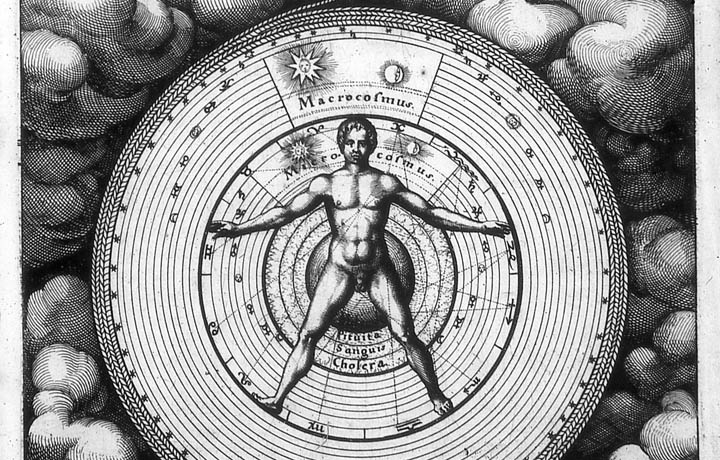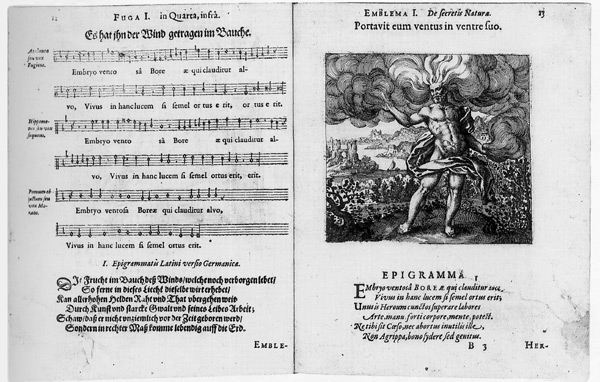
Alchemy: image and text in the late Renaissance
Modern scientific argument is primarily delivered in the written word – but that was not always the case. In issue 22 of Varoom Adrian Holme explores the moment in history when visual argument, and the rich use of illustration in the field of ‘Alchemy’, disappeared from the field of science. How can science, and our understanding of it benefit from using the image?
The Varoom article considers the nature of image and text in early 17th Century alchemical publications, exemplified by the works of Dr Robert Fludd and Michael Maier, and the shift in the nature of illustration in science that followed the rejection of alchemy by Francis Bacon and others. This shift is further contextualised in terms of wider cultural and philosophical trends that downgraded the status of visual imagery in serious discourse. For more see Varoom 22.

Michael Maier, (1613), Atalanta fugiens, 12-13. Oppenheim: de Bry. In: Klossowski de Rola, S, (1988), 71 (c) Thames and Hudson Ltd. London, 1988
Top image: Robert Fludd (1617). Utriusque cosmi. Vol. 1, p29. Second of the eighteen images depicting the creation of the Macrocosm. This image shows the appearance of Light in the Darkness Source: http://www.billheidrick.com/Orpd/RFludd/ (c) UC Berkeley and Bill Heidrick 2010
Adrian Holme is a lecturer on the BA Hons. Illustration course at Camberwell College of Arts, UAL, and an associate editor of the Journal of Illustration. He is also a practising artist and writer.
Bibiography for Alchemy: image and text in the late Renaissance
Arnheim, Rudolf (1971). Visual Thinking. Berkeley: Univ. California Press
Arasse, Daniel (2001). Anselm Kiefer. London: Thames and Hudson
Bacon, Francis (2004). The advancement of learning (First published 1605) http://www.gutenberg.org/dirs/etext04/adlr10h.htm (Accessed 1 June 2013)
Ball P (2007). The Devil’s doctor: Paracelsus and the world of Renaissance magic and science. London: Random House
Beuys J, Klein Y, Rothko M, Anthony d’Offay (firm) (1987). Beuys, Klein, Rothko: Transformation and Prophecy. London: Anthony d’Offay Gallery,
Bohm, D (1983). Wholeness and the Implicate Order, London: Ark Paperbacks,
Breidbach, Olaf. (2006). Visions of Nature: the art and science of Ernst Haeckel. Munich: Prestel
Burke, Edmund (2004). A philosophical enquiry into the sublime and beautiful. London: Penguin Classics
Cambell, John (2010). Rutherford – a brief biography. http://www.rutherford.org.nz/biography.htm (Accessed 1 June 2013)
Dampier WC (1971). A history of science: and its relations with philosophy & religion. Cambridge: Cambridge Univ. Press
Foucault, Michel. (2001). The order of things: an archaeology of the human sciences. London: Routledge
Freeman, Rosemary (1948). English emblem books. London: Chatto & Windus
Furnari M (1995). Formal design in Renaissance architecture: from Brunelleschi to Palladio. New York: Rizzoli International
Gibson WS (2006). Pieter Bruegel and the art of laughter. Berkeley: Univ California Press
Gombrich, Ernst H. (1984). Tributes: interpreters of our cultural tradition. Oxford: Phaidon
Gombrich, Ernst H (1985). Symbolic images: studies in the art of the Renaissance II London: Phaidon.
Hale J. (2005). The civilisation of Europe in the Renaissance. London: Harper
Heidrick, Bill. Robert Fludd’s Utriusque cosmi maioris salicet et minoris metaphysica. http://www.billheidrick.com/Orpd/RFludd/ (Accessed 1 June 2013)
Henry, John (2001). Scientific revolution and the origins of modern science. Gordonsville, VA: Palgrave Macmillan. http://site.elibrary.com/lib/ucreative/Doc?id=10076895&ppg=65 (Accessed August 3, 2010)
Huffman, William H (Ed.) (1992). Robert Fludd: essential readings. London: Harper Collins
Jay, Martin (1994). Downcast eyes: the denigration of vision in twentieth-century French thought. Berkeley: Univ. California Press
Jean, Georges (1998). Signs, symbols and ciphers: decoding the message. London: Thames and Hudson / New Horizons
Jung, CG. (1983). Alchemical studies. Transl. RFC Hull. Bollingen series XX, The collected works of C.G. Jung, Volume 13. (Eds. Read H, Fordham M, Adler G, McGuire W). New York: Princeton Univ. Press
Kemp, Martin (2006). Seen | unseen: art, science and intuition from Leonardo to the Hubble Telescope. Oxford: Oxford Univ. Press
Klossowski de Rola, Stanislas (1988). The golden game: alchemical engravings of the seventeenth century. London: Thames and Hudson
Linden, Stanton J. (1974). Francis Bacon and alchemy: the reformation of Vulcan. J of the History of Ideas. 35(4), 547-560
Linden, Stanton J. (2003) The alchemy reader: from Hermes Trismegistus to Isaac Newton. Cambridge: Cambridge Univ. Press
McLean A (2011). The alchemy web site. http://www.alchemywebsite.com/index.html (Accessed 1 June 2013)
McLuhan M (1962). The Guttenberg galaxy: the making of typographic man. Toronto: Toronto Univ Press
Michaud, Philippe-Alain (2004). Aby Warburg and the image in motion. Transl. Sophie Hawkes. New York: Zone Books
Mitchell, WJT. (1987). Iconology: image, text, ideology. Chicago: Univ. Chicago Press
Panofsky, Erwin. (1955) Meaning in the visual arts. Chicago: Univ. Chicago Press.
Panofsky, Erwin. (1972). Studies in iconology: humanistic themes in the art of the Renaissance. New York: Icon
Pauli, Wolfgang, (1992). The influence of archetypal ideas on the scientific theories of Kepler. (Excerpt). In: Huffman, William H. Robert Fludd: essential readings. London: Aquarian Press. Chapter 5, 121-145
Pyenson L and Sheets-Pyenson S. (1999). Servants of nature. A history of scientific institutions, enterprises and sensibilities. London: HarperCollins Publishers,
Quarles, Francis, (1639) Emblemes. [With “Hieroglyphikes of the life of man.” With engravings by William Marshall.] London: John Dawson for Francis Eglesfeild
Read, John (1933). Alchemy and alchemists. Folklore, 44(3). September, 251-278 http://www.jstor.org/stable/1256428 (Accessed 2 August 2010)
Roob, Alexander. (1997) The hermetic museum. Alchemy & mysticism. Koln: Taschen
Stafford, Barbara Maria (2001). Visual analogy: consciousness as the art of connecting. Cambridge, Mass.: MIT Press
Steadman, Philip (2008). The Evolution of Designs: Biological Analogy in Architecture and the Applied Arts. Abingdon, Oxford: Routledge
Thompson CJS. (1990). The lure and romance of alchemy. (First published 1932). New York: Bell Publishing
Weitemeier H (1995). Yves Klein, 1928-1962: International Klein Blue. Koln: Taschen
Yates, Frances (1972). The Rosicrucian enlightenment. London: Routledge
Primary Sources
Fludd, Robert (1607-1621). Utriusque cosmi maioris salicet et minoris metaphysica. Oppenheim: Johann Theodor de Bry. Warburg Institute, London, (July 2010) and online at http://www.billheidrick.com/Orpd/RFludd/ (Accessed 1 June 2013)
Kepler, Ioannis (1619). Harmonices Mundi, First edition, Lincii: Austriae. Facsimile, Posner Memorial Collection http://posner.library.cmu.edu/Posner/books/book.cgi?call=520_K38PI (Accessed 1 June 2013)
Quarles, Francis, (1639). Emblemes. [With “Hieroglyphikes of the life of man.” With engravings by William Marshall.] London: John Dawson for Francis Eglesfeild, British Library
Radio
In our time (2005) Alchemy BBC Radio 4, broadcast Thursday 24 February, 2005 http://www.bbc.co.uk/radio4/history/inourtime/inourtime_20050224.shtml (Accessed August 6, 2010)
Figures
Figure 2. Pieter Bruegel the Elder (c1558). The Alchemist. (pen and brown ink, 308 x 453 mm), Staatliche Museen, Kupferstichkabinett, Berlin. http://www.learn.columbia.edu/dbcourses/publicportfolio.cgi?view=591#
Figure 2. Hans Weiditz, (c1520) An alchemist http://www.levity.com/alchemy/weiditz.html
Figure 3. Michael Maier, (1613), Atalanta fugiens, 12-13. Oppenheim: de Bry. In: Klossowski de Rola, S, (1988), 71 (c) Thames and Hudson Ltd. London, 1988
Figure 4. Michael Maier, (1613) Atalanta fugiens, Oppenheim: de Bry. Copperplate engraving. In Klossowski de Rola, S, (1988), 76 (c) Thames and Hudson Ltd. London, 1988
Figure 5. Robert Fludd (1617). Utriusque cosmi historia (The metaphysical, physical, and technical history of the two worlds, namely the greater and the lesser). Volume 1, Title page. Oppenheim: Johann Theodor de Bry. Copperplate engraving. Source: http://www.billheidrick.com/Orpd/RFludd/ (c) UC Berkeley and Bill Heidrick 2010
Figure 6. Robert Fludd (1617). Utriusque Cosmi historia (The metaphysical, physical, and technical history of the two worlds, namely the greater and the lesser). Volume 1, p29. Oppenheim: Johann Theodor de Bry. With copperplate engraving. http://www.billheidrick.com/Orpd/RFludd/ (c) UC Berkeley and Bill Heidrick 2010
Figure 7. Robert Fludd (1617). Utriusque Cosmi historia (The metaphysical, physical, and technical history of the two worlds, namely the greater and the lesser). Volume 1, p132. Oppenheim: Johann Theodor de Bry. With copperplate engraving. Source: http://www.billheidrick.com/Orpd/RFludd/ (c) UC Berkeley and Bill Heidrick 2010
Figure 8. Robert Fludd (1617). Utriusque Cosmi historia (The metaphysical, physical, and technical history of the two worlds, namely the greater and the lesser). Volume 1, p109. Oppenheim: Johann Theodor de Bry. With copperplate engraving. Source: http://www.billheidrick.com/Orpd/RFludd/ (c) UC Berkeley and Bill Heidrick 2010
Figure 9. Ioannis Kepler (1619), Harmonices Mundi, Liber V, page 181, First edition, Lincii: Austriae. Source: Facsimile, Posner Memorial Collection http://posner.library.cmu.edu/Posner/books/book.cgi?call=520_K38PI (c) Posner Memorial Collection 2010